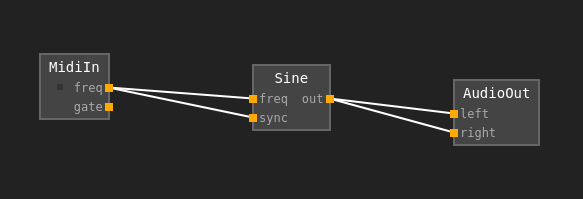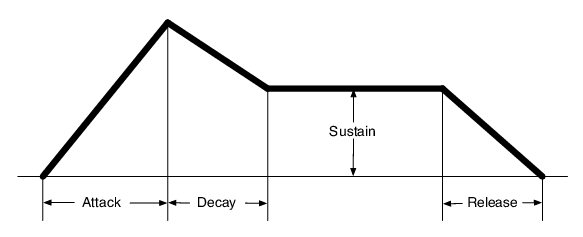Notes on Modular Synthesis
Wft:
These synths work by voltage (in the physical world; digital ones use simulated voltage). When you play a guitar or piano, you're playing different notes by pressing different keys, and each fret or key sounds in its own frequency, high or low. Synths use voltage (higher or lower) to designate a sound. When you increase voltage, you create a high pitched sound; when you decrease voltage going in, your sound becomes lower pitched. They use voltage (higher or lower) to do everything else, too, such as voltage controlled oscillator (making the oscillator pulse more or less rapidly by increasing or decreasing the voltage going in to it) or a voltage controlled filter. If you pump a high voltage into an oscillator, you'll produce a high note. If you put low voltage into a different oscillator (producing a slow transition between its high and low points of oscillation), then push that oscillator into your first high pitched oscillator (thereby controlling your high-frequency oscillator with your low-frequency one), you'll have a high pitched sound, but it will go higher and lower at the rate of your low-frequency oscillator, warbling.
In order to make a sounds, you need 1) an amplifier. This is the last module in your chain of patch cords conveying your signals. On a digital modular synth, this might be called "out," 2) an oscillator which produces a sound wave; 3) something to control the frequency going into the oscillator, which could be a midi keyboard, a step sequencer with some notes selected (which will also require a clock in front of it so it actually moves), or a knob that you turn up or down to increase or decrease frequency for your oscillator. First in your chain is your voltage (frequency) controller (keyboard, clocked sequencer, or knob), second is your oscillator which actually produces your sound wave, and finally your amp which can turn the frequency signal into sound waves.
Basics for a synth played with computer keyboard:

Basics for no keyboard (using a sequencer):

These were made using a browser synth: https://z.musictools.live/
How much voltage does what? Each octave means a different volt. 1 volt might make middle C. 2 volts then will make C one octave higher. Each note is therefore 1/12th volts different from its neighbour. Synths with keyboards do this stuff in their own wiring.
Gates. This means turning a sound on and off. They're used to start "envelope generators," starting and controlling sequencers and switches. Tapping a key, for example, means turning a switch on and off, although on a keyboard you probably won't have control over this (it will be built in).
Envelopes (the label for the component might saw "envelope generator" or "adsr") control 3 things: amplitude, pitch, and harmonics. But when you look at the knobs on an envelope, you don't see those words; you see 4 other words, which you can adjust: attack, decay, sustain, release. Forget pitch and harmonics right now, and we're going to consider an envelope that just controls amplitude (volume) of each note you press. If a note is tapped, you only have to worry about 2 things: attack and release. Attack is how quickly the sound "fades in" to its maximum volume, and release is how quickly the sound fades out after the key has been released. But your note is not going to keep "attacking" after you released the key; it's only going to attack as high as you give it time for with your short key press, and if that time isn't enough to get to it's high point, it won't get to it's high point. Now If you plan on holding the note, you have two other things to think about: when you press and hold your key, and the key reaches it's maximum volume (decided with "attack"), does it decrease in volume a bit before holding it's sound? This decrease is called "decay," where you're still holding the key and it's going to sustain, but it's going to come down a bit before it sustains. Sustain is, when holding the key, what volume it plays at for as long as you hold it or until it's sustain time runs out. When you release your key, you'll hear your "release" parameter as the sound fades out afterwards.

How to build a system:
Terms to Know (from https://www.synthesizers.com/begin.html )
- Amplifying - Increasing a signals volume.
- Analog - A signal that varies continuously.
- Attenuating - Lowering a signals volume.
- Control Voltage - .
- Controller - A device that creates signals used to control modules. Examples: keyboard, wheel, ribbon.
- Digital - A signal comprised of numerically computed values.
- Envelope - A waveform that changes over time used to control parameters of a signal such as filtering and amplitude.
- Gate - On/Off signal typically from a keyboard indicating a key is pressed. Used to trigger envelope generators.
- Inverting - Reversing of the polarity of a signal.
- Mixing - Combining of several signals. Technically, adding of voltages.
- Module - An component of a synthesizer that performs a function, typically with an audio signal and/or control voltages, and can be moved to other locations within the system.
- Monophonic - A system where only one note can be played at once. However, this note may contain many pitches from multiple oscillators.
- Normalized - A synthesizer where most of the patching between functions is fixed. Example: MiniMoog.
- Patch - A set of patch cables and module parameter settings used to create a specific sound.
- Semi-Modular - A synthesizer where functions are logically separated and patchable, but modules are fixed into one location. Example: ARP 2600.
- Sequencer - A component of a synthesizer that creates a series of voltages typically used to control oscillators, filters and other modules.
- VCO - Voltage Controlled Oscillator. Creates waveforms. Frequency/Pitch is determined by knobs and pitch control voltage.
- VCF - Voltage Controlled Filter. Removes harmonics from waveforms. Frequency is determined by knobs and control voltages.
- VCA - Voltage Controlled Amplifier. Controls amplitude (volume) of a signal. Amplitude deterimed by knobs and control voltages.
- Voltage Control - The concept where parameters are determined by voltages.
Tutorials here: https://www.synthesizers.com/tutorials.html
Interested to discuss? Leave a comment.
Your email will not be published nor shared with anyone. In your text you can use markdown for marking up *italic*, links <http://example.org> and other elements. These comments are moderated and published manually as soon as possible.
Comments: 0